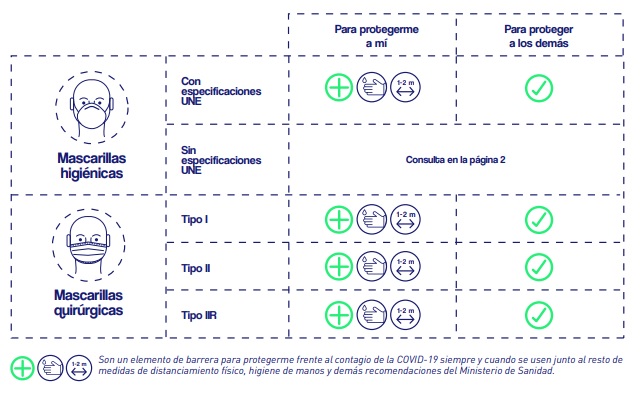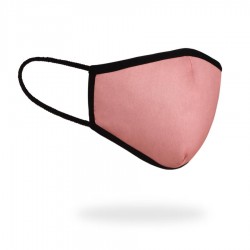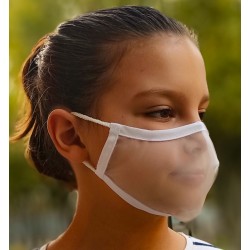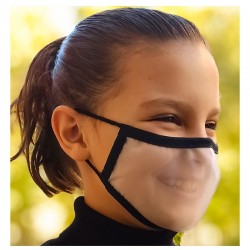Categorías
Adult
Approved Masks
Masks for Adults at Farma2Go
Wide variety of protective masks for adults against pathogens and viruses. Guarantee protection by purchasing approved masks of the type you need. Depending on the situation, one type or another of mask will be useful and effective. Protect your health and that of the rest of the people around you with masks with different degrees of particle filtration, adapted for low health risk environments and scenarios, or for times when very high protection is necessary, to work with infected people. or those who are at higher risk of complications from coronavirus symptoms or other infections.
Surgical Masks, FFP2, FFP3, KN95, Reusable or Hygienic Masks for Adults , in different colors, designs and of course, in smaller packs for occasional use or large volume boxes for continued and frequent use. It is very important to use masks of the appropriate size and measurement, since their objective is to prevent our breath from spreading throughout the environment. To do this, it is essential that the mask fits perfectly to our face, precisely fixing and adjusting the nose clip and the elastic bands to the ears, to avoid gaps or loose spaces that allow the diffusion of our breath and respiration. Ultimately, if we allow it to exit through other spaces, the mask loses all its functionality.
Not all adult masks have exactly the same measurements, so it is important that we adjust them properly with the elastic bands on the ears, shortening them if necessary to allow complete and total fixation to the surface and shapes of the face. Likewise, the nose clip must always be well adjusted to the nose, to prevent the mask from falling when moving or speaking. Remember to always wear your mask well adjusted and of your size, doing the same with children, for whom you must use children's masks and never these adult masks, as they would be ineffective and cumbersome for the little ones.
Measurements of Adult Masks
Adult masks have approximate measurements that they must all meet in order to perform the work for which they have been made. Approximately, masks for people over 12 years of age (in adolescents, depending on their growth and development) should measure approximately 18 centimeters wide and another 18 centimeters high. With five centimeters on the upper and lower edges and with alternating folds of 1 and 2 centimeters in the central part, to allow adjustment to the anatomical shapes of the face.
Types of masks
If you are looking to protect yourself from viruses, we can help you by passing on some of the recommendations that health authorities have made on this matter:
Hygienic masks: recommended for healthy people without contact with viruses, always together with the physical distancing and hygiene recommendations of the Ministry of Health.
Surgical masks: for people who have been infected, who have symptoms or who are asymptomatic positive.
PPE masks (FFP1, FFP2-KN95, FFP3): people who care for or are in contact with symptomatic or disease-positive people, people in contact with viruses, for vulnerable groups.
How do you put on a mask?
- Avoid touching the inside of the mask.
- Adjust the elastic band around your ears until you are in a comfortable position.
- Adjust the external face of the mask to the structure of the face until it is well deployed and sealed.
- Adjust the nose clip with both hands until it fits firmly on your nose.
- Change the mask if it is wet, damaged or if you have breathing difficulties.
The effectiveness of protection will depend largely on proper handling and use.

It is recommended that adults supervise the placement, use and removal of the mask in children.
European Regulations for Surgical Masks

To know if a mask complies with European regulations to be considered effective and guarantee that it is suitable as a complement to the physical distancing and hygiene measures recommended by health authorities for the prevention and control of infections, some of its characteristics can be observed. .
Their labeling must include a reference to the UNE standard, which is the regulation validated by the Spanish state health authorities to manufacture them:
-UNE 0064-1:2020: on non-reusable hygienic masks for adults.
-UNE 0064-2:2020: on non-reusable hygienic masks for children.
-UNE 0065:2020: in reusable toiletries for adults and children.
In addition, purchased masks must also contain, on their labeling, instructions or elsewhere, the following information: the manufacturer of the product, the name of the masks, their size and measurements, whether it is reusable or not, instructions for use, a list specifying the materials with which they are made and information on their maintenance, as well as the number and washing method if it is reusable.
Differences between Hygienic and Surgical Masks

To know the differences between them, you have to understand what each type of mask is for. The hygiene measures are a complement to the social distancing and hygiene measures recommended by the Spanish health authorities. They cover the orifices of the face that can exhale particles, covering the mouth, nose and chin. Provided with rubber bands that surround the head or are attached to the ears and composed of one or several layers of textile material. They can be reusable or single use.
For their part, surgical masks are those that we are used to seeing in healthcare and clinical environments, given that their objective is to prevent healthcare personnel and patients who are infected with a contagious virus from transmitting particles that carry these infectious agents. These masks filter exhaled air and protect those around them, preventing viral dispersion when performing everyday actions such as sneezing or coughing. Like hygienic ones, they are fixed to the face and adjusted using rubber bands or other mechanisms.
In addition, there are other types of masks, which are Personal Protective Equipment (PPE) , recommended especially for professionals who have to work in front of the public, since they create a barrier between the potential risk for the user. Thus, they filter the air both from inside to outside, and from outside to inside, protecting those around us and ourselves. Its purpose, in fact, is to filter the inhaled air, preventing the entry of contaminating particles into our body. Depending on their effectiveness, they can be FFP1, FFP2 or FFP3.




